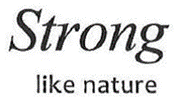Risk in simple sustainability brands – Strong like Nature
The case: Sustainability brands are often formed from the same descriptive words and hence seem more or less comparable. It is easy for a company that’s creating a new brand to lull itself into a false sense of security. After all, ‘such brands are everywhere and the brand has to be able to communicate its message.’
This may well have been the attitude of St. Hippolyt Holding GmbH, which is well known in equestrian sport. It applied for the following sustainability mark, among others, for food supplements for veterinary purposes as a Union trade mark:

When the Serbian company Elephant Pharma, whose EU trade mark protected dietetic substances, opposed this

new mark, St. Hippolyt defended itself with a recognisable argument: Elephant’s trade mark consists of the descriptive words STRONG and NATURE and a simple figurative element. It could therefore hardly distinguish Elephant’s goods. In such a situation, it argued, even slight differences between the conflicting signs are sufficient to eliminate the likelihood of confusion. In addition, it said, these elements had been integrated into the mark. The graphics were different, one had an additional word and the figurative element was missing from St. Hippolyt’s mark.
What is to be made of this?
It is true that the individual elements of the earlier mark are not very distinctive in themselves. But they contain a particular arrangement and combination of elements, in addition to a particular colour design. This gives the mark a normal degree of original distinctiveness, as the General Court of the European Union (CFI) found.
Thus, Hippolyt’s initial assessment was wrong at the outset. The older mark could in fact pose a danger to the new sign.
But were the signs in any way visually, phonetically or conceptually similar enough to each other to give rise to a likelihood of confusion? The younger mark contained the additional word ‘like’. The appearance of the two marks was also ‘clearly different’ because of the figurative element of the earlier mark, as the CFI also found.
However, it should be noted that consumers tend to recognise brands based on word elements rather than images or picture elements. And the words STRONG and NATURE took up the largest proportion of each of the signs. Therefore, when it came down to these simple words alone, there was indeed a low degree of visual similarity, and since the words STRONG and NATURE appeared in the same order, the signs were also phonetically and conceptually similar.
As a result, the trade mark application failed due to likelihood of confusion.
Court of Justice of the European Union, 20 October 2021, T-352/20.
Learnings: If you create sustainability brands from more or less descriptive terms, don’t assume that everyone is doing it and there will be no consequences. It is better to analyse the older signs consisting of the same terms in order to ascertain any potential danger. If your sign infringes an earlier trade mark and its owner takes action against you, your trade mark will, at best, fail in the application procedure. At worst, in costly infringement proceedings, you may also be forced to pay damages and destroy any of your goods marked with the trade mark.